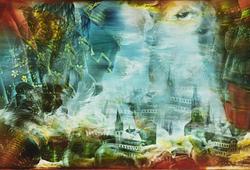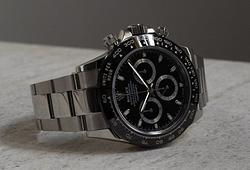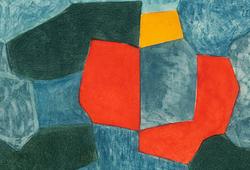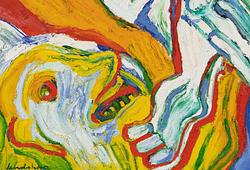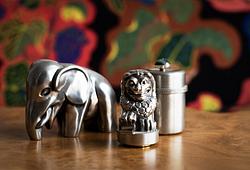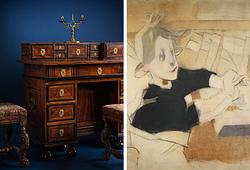Nils von Dardel
Study for "Visit hos excentrisk dam"
Executed in 1921. Mixed media on paper, 35.5 x 25 cm.
Alkuperä - Provenienssi
Doctor Carl Kempe.
Veronica Björling.
Private collection.
Näyttelyt
Liljevalchs Konsthall, Stockholm, Sveriges Allmänna Konstförening, "Nils Dardel", 25 March - 1 May, 1955, cat. no 171.
Moderna Museet, Stockholm, 30 January - 3 April, 1988.
Kirjallisuus
Karl Asplund, "Nils Dardel - del I Ungdomstiden", SAKs publication LXVI, 1957, listed under works 1921, p. 260.
Muut tiedot
Vincent van Gogh is said to have stated that art is to console those who are broken by life. And when it comes to Nils von Dardel’s art from 1919 and a few years thereafter, there seems to be some truth in that.
After the end of his relationship with Nita Wallenberg, Dardel worked furiously, creating some of his most iconic works. All three of his major works from these years; “Den döende Dandyn” (The Dying Dandy) (1918), “Crime Passionnel” (1921) and “Visit hos excentrisk dam” (Visit to an Eccentric Lady) (1921), were preceded by preliminary studies (in watercolour/gouache) which differ in intriguing ways from the final compositions (in oils). In the original study for The Dying Dandy everyone in the composition is male, while the version in oils depicts women grieving for the dying man. In “Dam i grön pyjamas, mördande herre i svarta” (Lady in Green Pyjamas Murdering a Gentleman in Black) it is clear, as it also is from the title, that it is a man dying from the pistol shot, while the drama in the oil painting is played out between two much more androgenous characters. The study in the auction for “Visit to an Eccentric Lady” seems to be more of an independent work and could be interpreted as having several personal keys and recurring symbols for understanding Dardel’s art.
The location of the watercolour, in the auction, bears clear signs of being an orangery or greenhouse, with the cupola-shaped roof and palm leaves dominating the background. They almost hide one of the more macabre elements in the painting – the hanging man, which several Dardel experts interpret as representing the artist himself. In the preceding watercolour, however, it is interesting that the artist placed a different alter ego; the dandy, in conversation with the eccentric lady, creating an interesting dynamic between these two symbols.
Around the three main characters several animals can be seen which, following his trip to Japan, Dardel regularly featured in his work. Animals often take on human and moral characteristics in Japanese art and, therefore, they can act as a useful motif for artists trying to communicate a message. We often encounter animals in Dardel’s work and the watercolour “Visit to an Eccentric Lady” features a monkey, a peacock and a deer; all powerful symbols in Japanese art. The melancholy deer is a recurring element, said to reflect innocence and purity, and plays a major role in the watercolour “Ynglingen och flickan” (The Young Man and the Girl) (1919). The monkey can often have erotic connotations and reflect unabashed impulsivity. In Paris during the 1910s and 1920s, monkeys were considered a fashionable and highly chic accessory. Dardel himself gave a monkey to Jeanné Legér, the wife of his good friend, the artist, Fernand, which she apparently named “Nils”.
In the version of “Visit to an Eccentric Lady” in oils, all the elements have been accentuated by the artist – the hanging man is more prominent and the eccentric lady even more so, with a monkey and a vase balancing on her head. The ladder is found in both versions – in the version in the auction, it is used by monkeys in costume, while in the oil painting, Dardel’s good friend, the artist Philip Fromén is seated on it fishing, wearing what looks like a page’s costume. In the version in oils, the composition is busier with space filled by animals and visitors. The background has completely lost the sense of a greenhouse and instead feels much more like a studio. Its precursor in the auction should be seen more as a composition in its own right, with the wounded and divided ‘new-self’ more clearly evident. As a viewer, this version feels easier to follow as the narrative is more pared down and honest.





